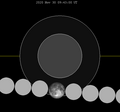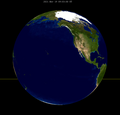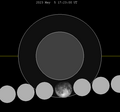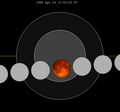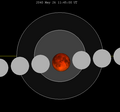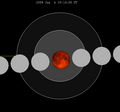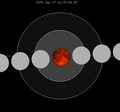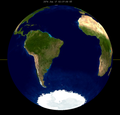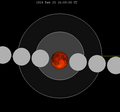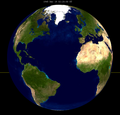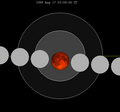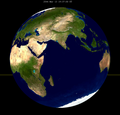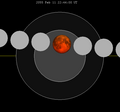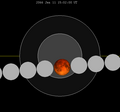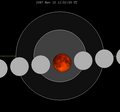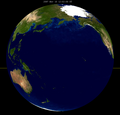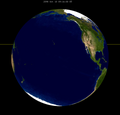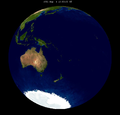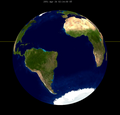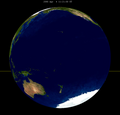Top Qs
Timeline
Chat
Perspective
May 2022 lunar eclipse
Total lunar eclipse of 15–16 May 2022 From Wikipedia, the free encyclopedia
Remove ads
A total lunar eclipse occurred at the Moon’s descending node of orbit on Monday, May 16, 2022,[1] with an umbral magnitude of 1.4155. It was a central lunar eclipse, in which part of the Moon passed through the center of the Earth's shadow. A lunar eclipse occurs when the Moon moves into the Earth's shadow, causing the Moon to be darkened. A total lunar eclipse occurs when the Moon's near side entirely passes into the Earth's umbral shadow. Unlike a solar eclipse, which can only be viewed from a relatively small area of the world, a lunar eclipse may be viewed from anywhere on the night side of Earth. A total lunar eclipse can last up to nearly two hours, while a total solar eclipse lasts only a few minutes at any given place, because the Moon's shadow is smaller. Occurring about 1.3 days after perigee (on May 17, 2022, at 11:30 UTC), the Moon's apparent diameter was larger.[2]
Because this event occurred near lunar perigee, it was referred to some in media coverage as a "super flower blood moon"[Note 1][3][4][5] and elsewhere as a "super blood moon",[6][7][8] a supermoon that coincides with a total lunar eclipse. This was the longest total lunar eclipse visible from nearly all of North America since August 17, 1989 until the next eclipse on November 8.[9][10]
The eclipse was a dark one with the northern limb of the Moon passing through the center of Earth's shadow. This was the first central eclipse of Lunar Saros 131.
This lunar eclipse was the third of an almost tetrad, with the others being on May 26, 2021 (total); November 19, 2021 (partial); and November 8, 2022 (total).
Remove ads
Visibility
The eclipse was completely visible over North and South America, seen rising over western North America and the central Pacific Ocean and setting over Europe and Africa.[11]
  |
 Visibility map |
Gallery
North and South America
- Spring Hill, FL 10:45 UTC
- Los Angeles, CA at moonrise, 3:08 UTC
- Buenos Aires, Argentina, 3:26 UTC
- Minneapolis, MN, 3:34 UTC
- San Antonio, TX, 3:36 UTC
- Santa Ana, CA at 4:13 UTC
- Mexico City, Mexico, 4:15 UTC
- Greenville County, SC, 4:15 UTC
- Houston, TX, 4:16 UTC
- Sacramento, CA, 4:33 UTC
- Eclipse progression as seen from Linden Hills, Minneapolis
- From Irvine, California at 4:44 UTC
Europe
- Eclipse progression as seen from Oria, Italy
- Berlin, Germany at moonset, 2:52 UTC
- Totality from Marseille, France
- Animation from Madrid, Spain
Remove ads
Eclipse details
Shown below is a table displaying details about this particular solar eclipse. It describes various parameters pertaining to this eclipse.[12]
Eclipse season
This eclipse is part of an eclipse season, a period, roughly every six months, when eclipses occur. Only two (or occasionally three) eclipse seasons occur each year, and each season lasts about 35 days and repeats just short of six months (173 days) later; thus two full eclipse seasons always occur each year. Either two or three eclipses happen each eclipse season. In the sequence below, each eclipse is separated by a fortnight.
Remove ads
Related eclipses
Summarize
Perspective
Eclipses in 2022
- A partial solar eclipse on April 30.
- A total lunar eclipse on May 16.
- A partial solar eclipse on October 25.
- A total lunar eclipse on November 8.
Metonic
- Preceded by: Lunar eclipse of July 27, 2018
- Followed by: Lunar eclipse of March 3, 2026
Tzolkinex
- Preceded by: Lunar eclipse of April 4, 2015
- Followed by: Lunar eclipse of June 26, 2029
Half-Saros
- Preceded by: Solar eclipse of May 10, 2013
- Followed by: Solar eclipse of May 21, 2031
Tritos
- Preceded by: Lunar eclipse of June 15, 2011
- Followed by: Lunar eclipse of April 14, 2033
Lunar Saros 131
- Preceded by: Lunar eclipse of May 4, 2004
- Followed by: Lunar eclipse of May 26, 2040
Inex
- Preceded by: Lunar eclipse of June 4, 1993
- Followed by: Lunar eclipse of April 26, 2051
Triad
- Preceded by: Lunar eclipse of July 16, 1935
- Followed by: Lunar eclipse of March 17, 2109
Lunar eclipses of 2020–2023
This eclipse is a member of a semester series. An eclipse in a semester series of lunar eclipses repeats approximately every 177 days and 4 hours (a semester) at alternating nodes of the Moon's orbit.[13]
The penumbral lunar eclipses on January 10, 2020 and July 5, 2020 occur in the previous lunar year eclipse set.
Metonic series
The Metonic cycle repeats nearly exactly every 19 years and represents a Saros cycle plus one lunar year. Because it occurs on the same calendar date, the Earth's shadow will be in nearly the same location relative to the background stars.
|
|
 |
 |
Saros 131
This eclipse is a part of Saros series 131, repeating every 18 years, 11 days, and containing 72 events. The series started with a penumbral lunar eclipse on May 10, 1427. It contains partial eclipses from July 25, 1553 through March 22, 1932; total eclipses from April 2, 1950 through September 3, 2202; and a second set of partial eclipses from September 13, 2220 through April 9, 2563. The series ends at member 72 as a penumbral eclipse on July 7, 2707.
The longest duration of totality will be produced by member 38 at 100 minutes, 36 seconds on June 28, 2094. All eclipses in this series occur at the Moon’s descending node of orbit.[14]
Eclipses are tabulated in three columns; every third eclipse in the same column is one exeligmos apart, so they all cast shadows over approximately the same parts of the Earth.
Tritos series
This eclipse is a part of a tritos cycle, repeating at alternating nodes every 135 synodic months (≈ 3986.63 days, or 11 years minus 1 month). Their appearance and longitude are irregular due to a lack of synchronization with the anomalistic month (period of perigee), but groupings of 3 tritos cycles (≈ 33 years minus 3 months) come close (≈ 434.044 anomalistic months), so eclipses are similar in these groupings.
Inex series
This eclipse is a part of the long period inex cycle, repeating at alternating nodes, every 358 synodic months (≈ 10,571.95 days, or 29 years minus 20 days). Their appearance and longitude are irregular due to a lack of synchronization with the anomalistic month (period of perigee). However, groupings of 3 inex cycles (≈ 87 years minus 2 months) comes close (≈ 1,151.02 anomalistic months), so eclipses are similar in these groupings.
Half-Saros cycle
A lunar eclipse will be preceded and followed by solar eclipses by 9 years and 5.5 days (a half saros).[16] This lunar eclipse is related to two annular solar eclipses of Solar Saros 138.
| May 10, 2013 | May 21, 2031 |
|---|---|
 |
 |
Remove ads
See also
Notes
- A full moon occurring in May has been termed a "Flower moon" in the US as recorded in the Old Farmer's Almanac.
References
External links
Wikiwand - on
Seamless Wikipedia browsing. On steroids.
Remove ads


























